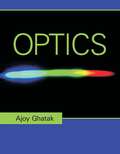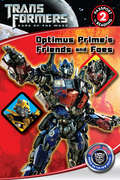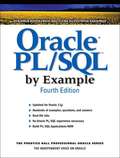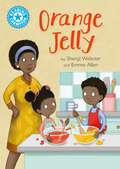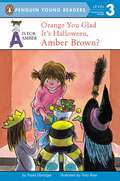- Table View
- List View
Opinions about Workers' Rights: The 1913 Ludlow Coal Miners' Strike
by James Palmer Jeffrey B. Fuerst Kim T. GriswellIn 1913 Colorado miners went on strike to protest unsafe conditions, low pay, and a very long workday. Read this historical fiction story based on that tragic-but-pivotal event in the development of the American labor movement. Then read the opinions of three writers about whether or not going on strike was the right thing to do.
Oppiyal Ilakkiyam
by K. KailasapathyThe book talks about Comparative Literature, and it is a compilation of different essays by the author under the topic like Comparative Literature’s philosophies, research in the field,Tamil Heroic Age etc.
Optical Illusions: Games for Your Brain (Fountas & Pinnell Classroom, Guided Reading Grade 4)
by Katherine BurkettNIMAC-sourced textbook
Optical Physics
by A. LipsonAimed at undergraduate and advanced courses on modern optics, it is ideal for scientists and engineers. The book covers the principles of geometrical and physical optics, leading into quantum optics, using mainly Fourier transforms and linear algebra. Chapters are supplemented with advanced topics and up-to-date applications, exposing readers to key research themes, including negative refractive index, surface plasmon resonance, phase retrieval in crystal diffraction and the Hubble telescope, photonic crystals, super-resolved imaging in biology, electromagnetically induced transparency, slow light and superluminal propagation, entangled photons and solar energy collectors. Solutions to the problems, simulation programs, key figures and further discussions of several topics are available at www.cambridge.org/lipson.
Optics
by Ajoy GhatakOptics by Professor Ghats is a classic text designed to provide a comprehensive account of important topics in this exciting field. The book aims to meet the requirements of a course on Optics for undergraduate students of science and engineering. This brand new multi-colour edition comes with a number of careful revisions in the text and colourful illustrations, thus making it even more exciting and reader friendly.
Optimus Prime's Friends and Foes (Transformers )
by Katharine TurnerIn this Level 2 reader based on Transformers: Dark of The Moon, Optimus Prime is on a quest for peace, but the Decepticons have other plans. Can Optimus Prime and his friends defeat their robot foes? © Hasbro
Oracle PL/SQL by Example (4th edition)
by Benjamin Rosenzweig Elena Silvestrova RakhimovUsing hands-on labs, extensive examples, exercises, and projects, this tutorial teaches basic PL/SQL concepts and general programming fundamentals, covering conditional and iterative program control techniques, error and exception handling, working with cursors and triggers (including Oracle 11g's new compound triggers), and working with advanced PL/SQL capabilities such as object-relational features and bulk SQL. Appendices offer a PL/SQL formatting guide, sample database schema, and an ANSI SQL standards reference. Rosenzweig is a software development manager. Rakhimov is a software developer. Annotation ©2008 Book News, Inc. , Portland, OR (booknews. com)
Orange Jelly: Independent Reading Blue 4 (Reading Champion #599)
by Sheryl WebsterThis story is part of Reading Champion, a series carefully linked to book bands to encourage independent reading skills, developed with Dr Sue Bodman and Glen Franklin of UCL Institute of Education (IOE)The children want to make orange jelly, but Mum only has red or yellow. Luckily, she has a good idea ...Reading Champion offers independent reading books for children to practise and reinforce their developing reading skills.Fantastic, original stories are accompanied by engaging artwork and a reading activity. Each book has been carefully graded so that it can be matched to a child's reading ability, encouraging reading for pleasure.Perfect for 5-6 year olds or those reading book band blue 4.
Orange You Glad It's Halloween, Amber Brown? (A Is for Amber #6)
by Paula DanzigerHalloween is one of Amber brown's favorite holidays, and this year she has come up with a fantastic costume. It's so perfect that she's keeping it a secret even from her best friend, Justin, no matter what he bribes her with. Amber can't wait to reveal the surprise and go trick-or-treating, but she's worried that her parents' arguing will put a damper on the holiday. But with pumpkin decorating, Halloween jokes, candy treats, and the greatest costume ever, this is going to be the perfect Halloween!
Orbit and Rotation: Science Logbook (PhD Science™ #Level 5, Module 4)
by Great MindsNIMAC-sourced textbook
Oregon Adventures in Time and Place
by James A. Banks Walter C. Parker Gloria Ladson-Billings Barry K. Beyer Gloria Contreras Jean Craven Mary A. McfarlandHistory of Oregon
Oregon Focus on Data Analysis [Stage 3]
by Beth Armstrong Matt Mccaw Shannon MccawNIMAC-sourced textbook
Oregon Focus on Fractions and Decimals [Stage 1]
by Beth Armstrong Matt Mccaw Shannon MccawNIMAC-sourced textbook
Oregon Focus on Introductory Algebra [Stage 1]
by Beth Armstrong Matt Mccaw Shannon MccawNIMAC-sourced textbook
Oregon Focus on Introductory Algebra, Teacher Resources, Student Materials [Stage 1]
NIMAC-sourced textbook
Oregon Focus on Linear Equations [Stage 3]
by Beth Armstrong Matt Mccaw Shannon MccawNIMAC-sourced textbook
Oregon Focus on Lines & Angles [Stage 3]
by Beth Armstrong Matt Mccaw Shannon MccrawNIMAC-sourced textbook
Oregon Focus on Proportionality [Stage 2]
by Beth Armstrong Matt Mccaw Shannon MccawNIMAC-sourced textbook
Oregon Focus on Rational Numbers & Equations [Stage 2]
by Beth Armstrong Matt Mccaw Shannon MccawNIMAC-sourced textbook
Oregon Focus on Ratios, Rates and Percents [Stage 1]
by Beth Armstrong Matt Mccaw Shannon MccrawNIMAC-sourced textbook
Oregon Focus on Surface Area & Volume [Stage 2]
by Beth Armstrong Matt Mccaw Shannon MccrawNIMAC-sourced textbook

